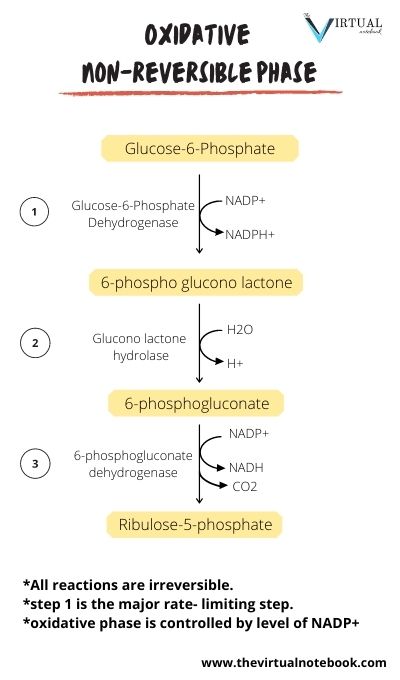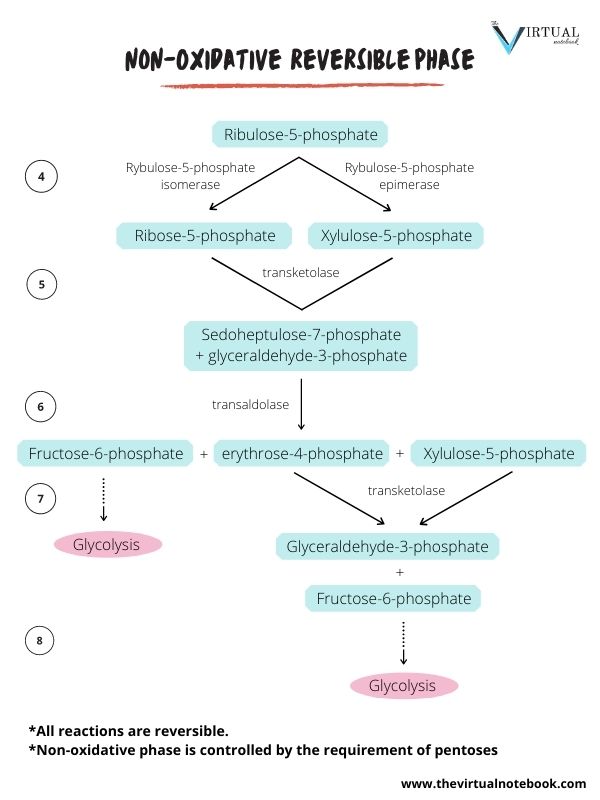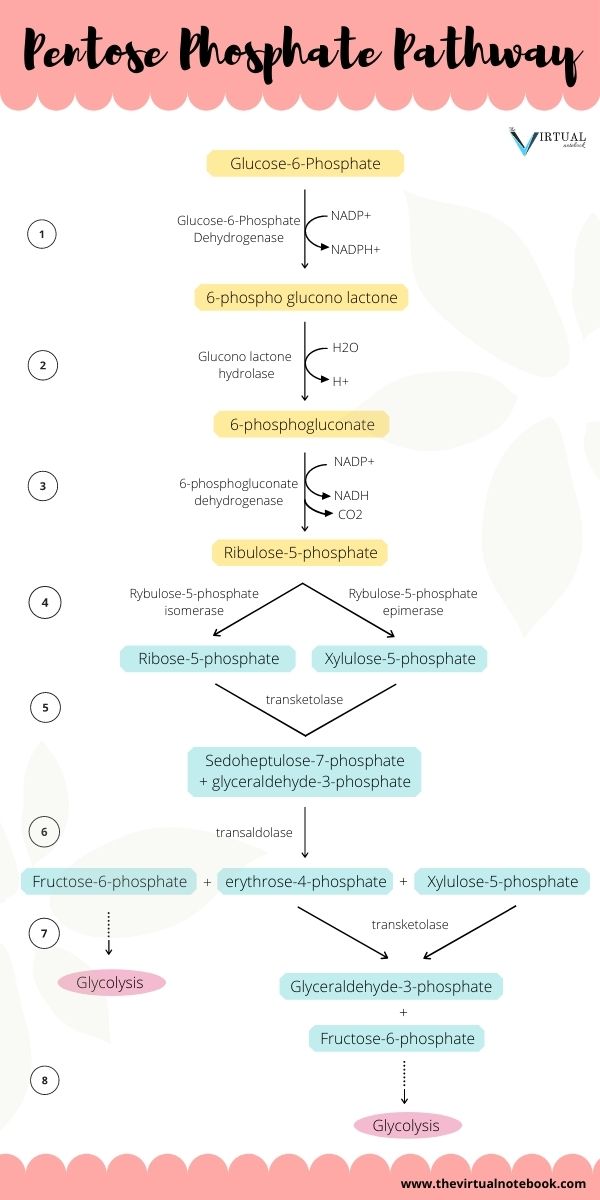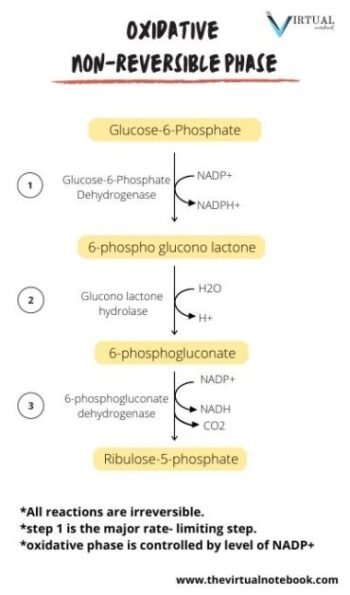PENTOSE PHOSPHATE PATHWAY
The pentose phosphate pathway is an alternative route for the metabolism of glucose. It functions side by side with glycolysis and the tricarboxylic acid cycle for the production of reducing power in the form of NADPH and pentose intermediates. Here, please note that no ATP is directly consumed or produced in the cycle. Pentose phosphate pathway occurs in the cytosol (cytoplasm) of the cell. In plants, most steps take place in plastids.
There are two distinct phases in the pathway. The first is the oxidative phase, in which the generation of NADPH takes place, and the second is the non-oxidative phase in which the synthesis of 5-carbon sugars occurs.
Pentose phosphate pathway is also known as the ‘hexose monophosphate shunt‘ (HMP) or just shunt pathway, and the ‘phosphogluconate oxidative pathway‘.The pentose phosphate pathway occurs in the cytosol of the cell.
About 10% of glucose molecules per day are entering this pathway. The liver and RBC metabolize about 30% of glucose by this pathway.
GLYCOLYSIS AND PENTOSE PHOSPHATE PATHWAY
- Glycolysis is the major pathway for glucose metabolism in which glucose will convert to pyruvate or lactate. On the other hand, the pentose phosphate pathway is an alternative route for the metabolism of glucose.
- Although glucose 6-phosphate is common to both pathways, the HMP shunt pathway is markedly different from glycolysis. Oxidation step utilizes NADP rather than NAD in PP pathway. Further, no ATP is generated in the pentose phosphate pathway, whereas it is a major product of glycolysis.
- The HMP shunt pathway provides a means for cutting the carbon chain of a sugar molecule one carbon at a time. However, in contrast to glycolysis and the tricarboxylic acid cycle, the operation of this pathway does not occur as a consecutive set of reactions.
- In glycolysis, there are a few bisphosphate intermediates; but in the shunt pathway, there are monophosphates only.
- Like glycolysis, the enzymes of the HMP shunt pathway are cytosolic.
- Unlike glycolysis, oxidation will achieve by dehydrogenation using NADP +, not NAD +, as the hydrogen acceptor.
For more info: see Glycolysis
See also: Tricarboxylic acid cycle
PENTOSE PHOSPHATE PATHWAY SUMMARY
The pentose phosphate pathway occurs in the cytosol and accounts for the complete oxidation of glucose, producing NADPH and CO2 but not ATP.
The sequence of reactions of the pathway occurs in two phases: an oxidative nonreversible phase and a nonoxidative reversible phase. Firstly, glucose 6-phosphate undergoes dehydrogenation and decarboxylation to yield a pentose, ribulose 5-phosphate. After that, ribulose 5-phosphate converts back to glucose 6-phosphate by a series of reactions involving mainly two enzymes: transketolase and transaldolase.
Because the nonoxidative reactions are reversible, they generate ribose-5-phosphate for nucleotide synthesis from intermediates of glycolysis.
REACTIONS OF PENTOSE PHOSPHATE PATHWAY
PPP has two phases:
- Oxidative reactions: It completes in total 3 steps and the reactions are irreversible.
- Non-oxidative reactions: it involves 5 reversible reactions.
The Oxidative reactions

- Firstly, Oxidation of glucose-6-phosphate occurs by NADP+ dependent Glucose-6-phosphate dehydrogenase (GPD). As a result, 6-phospho gluconolactone will form. Additionally, one molecule of NADPH will form in the reaction. The conversion of G6P to phospho gluconolactone is the major rate-limiting step.
- Secondly, the lactone is hydrolyzed by gluconolactone hydrolase to form 6-phosphogluconate.
- This is an oxidative step coupled with decarboxylation. 6- Phosphogluconate undergoes an oxidation reaction, followed by decarboxylation. The enzyme is 6-phosphogluconate dehydrogenase.
- Firstly, 3-keto-6-phosphogluconate (a transient compound) will form. After that, it will spontaneously undergo decarboxylation to form ribulose-5-phosphate.
- During this reaction, CO2 releases, and a second NADPH and H+ generates from NADP+. In this step, the second molecule of NADPH will form.
Non-oxidative reactions

- In this step, isomerization of the ribulose-5-phosphate to ribose-5-phosphate occurs (xylose-5-phosphate in case of epimerization).
- Transketolase is a thiamine pyrophosphate (TPP) dependent enzyme. It transfers two-carbon unit (with keto group) from xylulose-5-phosphate to ribose-5-phosphate to form sedoheptulose-7-phosphate and glyceraldehyde-3-phosphate. Transketolase enzyme will transfer the group from a donor ketose to an aldose acceptor.
- The next group transfer reaction involves the transfer of a 3 carbon unit, from sedoheptulose-7-phosphate to glyceraldehyde-3-phosphate to form fructose-6-phosphate. Here also the donor is a ketose and acceptor is an aldose.
- In another transketolase reaction, a 2C unit will transfer from xylulose-5-phosphate to erythrose-4-phosphate to form fructose-6-phosphate and 2 molecules of glyceraldehyde-3-phosphate.
- Glyceraldehyde-3-phosphate will condense to form one fructose-6-phosphate. After that, Fructose-6-phosphate will convert to glucose-6-phosphate.
The overall reactions of the HMP pathway
3 Glucose-6-P + 6 NADP+ → 3 ribulose-5-P + 3 CO2 + 6 NADPH
3 Ribulose-5-P → 2 xylulose-5-P + ribose-5-P
2 Xylulose-5-P + ribose-5-P → 2 fructose-6-P + glyceraldehyde-3-P
Net reaction of HMP pathway
G-6-P + 12 NADP+ + 7H2O→ 6CO2 + 2NADPH + 12H+ + Pi
PENTOSE PHOSPHATE PATHWAY PRODUCTS
- Reducing equivalents in the form of NADPH.
- Ribose 5-phosphate (R5P)
- Xylulose-5-phosphate
- six molecules of CO2
Please note that ATP is neither used nor produced by the HMP shunt pathway. Cells do not use the shunt pathway for energy production.
PENTOSE PHOSPHATE PATHWAY DIAGRAM

REGULATION OF PENTOSE PHOSPHATE PATHWAY
The level of NADP+ plays a major role in the regulation of the HMP pathway. The first reaction catalyzed by GPD is the rate-limiting step. It is allosterically stimulated by NADP+ and strongly inhibited by NADPH. The oxidative phase is therefore controlled by the level of NADP+ and the nonoxidative phase by the requirement of pentoses. Insulin will induce GPD and therefore will increase the overall pathway. When more NADPH is needed, the pathway proceeds to completion with the equivalent of one molecule of glucose being completely oxidized to CO2
SOURCES AND EXTERNAL LINKS
Note: page numbers may vary correspondingly upon the edition.
Textbook of biochemistry for medical students 7th edition by DM Vasudevan; Chapter 10: Other metabolic pathway of glucose, page no. 129 to 132
Additionally, BRS Biochemistry 6th edition, molecular biology, and genetics by Michael A. Lieberman, PhD and Rick Ricer; chapter no. 6: carbohydrate metabolism, page no. 212 to 215.
Also, Lippincotts illustrated review biochemistry 6th edition; chapter 13: Pentose Phosphate Pathway and Nicotinamide Adenine Dinucleotide
Phosphate, page no. 277 to 281.
Harper’s Illustrated Biochemistry 28th edition; Chapter 21. The Pentose Phosphate Pathway & Other Pathways of Hexose Metabolism, page no. 363 to 371.
Lastly, Textbook of biochemistry with Clinical Correlations 4th edition by Thomas L Delvin; chapter 8, 8.2: pentose phosphate pathway.
https://en.wikipedia.org/wiki/Pentose_phosphate_pathway
